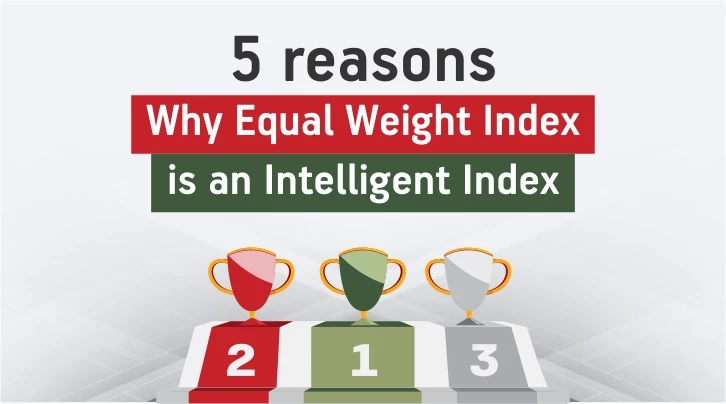-
Our Products
Our FundsFocus Funds
-
Self Care
Self-ServiceFind InformationWays To TransactPartner Solutions
-
Downloads
- Learnings
- About Us
-
More
-
Shareholders
-
Shareholders
-
Updates
-
-
SIP Calculators
- Back
-
Shareholders
5 reasons why Equal Weight Index is an Intelligent Index

May 28, 2021
2 mins
5 Rating

In recent times, the popularity of Index investing has been on the rise. In fact, the portfolio of Index fund folios has doubled from January 2020 to March 2021; with assets under management increasing from INR 7900 cr to INR 17,800 cr1. An affinity to a passive investing style with lower stock selection risk is perhaps driving this trend. But what if you could get the ease and simplicity of passive investing and yet be able to generate some alpha for your investments?
An alternative weighting index strategy such as ‘Equal Weight Index investing’ can achieve this for you.
Also Check -
What are Index Funds?
What is an Equal Weight Index?
Simply put, an Equal Weight Index is an index that allocates the same weight to each of its portfolio constituents. So, for example, if the index comprises of 50 stocks, each stock will have a proportion of ~2% in an equal weight index. The NIFTY 50 Equal Weight TRI is an example of an equal weight version of the popular NIFTY 50 Index.
This simple tweak in index methodology gives this ‘Intelligent Index’ an edge over its peer index, a market-cap based index. So, here are a few features that can give an Equal Weight Index an edge.
Smarter returns - believes every stock is a star and deserves a chance to shine!
With every stock having the same contribution to the price of the index, an Equal Weight Index throws open the floor for all of its constituent stocks to perform. In a broad- based rally where growth is expected to be boosted by a plethora of companies rather than a select few, an Equal Weight index can have the potential to outperform in long run
As a more inclusive growth trajectory begins, let’s say for example the 5-lower market-cap stocks significantly outperform the top 5 market cap stocks. With a total allocation of say just around 5% in the market cap-index visa-a-vis an allocation of 10% in the equal weighted index; these stocks can give a bigger push to the price performance of the equal weighted index.Lowers concentration risk!
An equal weight index also has a smarter in-built risk management strategy. With an equal allocation premise, the portfolio is more diversified across stocks as well as sectors. An equal weight index can thus be less susceptible to the sluggish performance of a particular stock or sector.
Let’s say for example the market cap-based index has a 35% allocation to the financial services sector vis-à-vis a more balanced 15% allocation in the equal weight index. A sudden crash in this sector can cause a considerable downfall in the market cap index as against the equal weighted index who can be less adversely effected owing to a lower exposure.Adjusts profits along the way!
An equal weighted index is periodically reconstituted and rebalanced. A reconstitution is for stocks to move in and out of the index based on its indexing methodology and rebalancing is to factor in inter-se price movements and re-align allocation across stocks to an equal weight.
Stocks that have outperformed and have become overweight will be sold and others will be bought. This leads to an automatic profit adjustment on each rebalancing date. This automated smart feature of an equal weight index periodically can convert notional profits into actual booked profits.Unlocks value!
When the growth base in an economy widens, new sectors emerge as frontrunners and new market leaders emerge. An equal weighted index allows otherwise lower ranked companies in a market-cap based index to move up the ranks. An ‘under-valued’ company when given an equal allocation in the index can unlock significant value for the index.
Right sizing – Neutralising market bias
Another advantage to the periodic reconstitution and rebalancing is that balance in the index is maintained, without allowing market-bias to creep in. In a market-cap based index, certain stocks may rise based on market sentiment rather than pure fundamental reasons, thus occupying a larger proportion in the Index. This short-lived upswing can cause a significant fall in performance when the market corrects. An equal weight index neutralises this market bias, keeping stocks at equal weights.
These features make Equal Weight Index investing an enhanced indexing strategy, specifically in times of broad-based economic recovery. Follow this link https://bit.ly/34ymhMx to know how you can capitalise on investing in a ‘Simple yet Smart and Intelligent’ Equal Weighted Index.
Mutual Fund investments are subject to market risks, read all scheme related documents carefully.





 1800-270-7000
1800-270-7000



